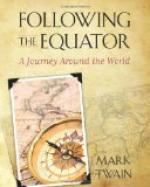We were interested in the wardrobe and the jewels, and in the silverware, and its grace of shape and beauty and delicacy of ornamentation. The silverware is kept locked up, except at meal-times, and none but the chief butler and the prince have keys to the safe. I did not clearly understand why, but it was not for the protection of the silver. It was either to protect the prince from the contamination which his caste would suffer if the vessels were touched by low-caste hands, or it was to protect his highness from poison. Possibly it was both. I believe a salaried taster has to taste everything before the prince ventures it—an ancient and judicious custom in the East, and has thinned out the tasters a good deal, for of course it is the cook that puts the poison in. If I were an Indian prince I would not go to the expense of a taster, I would eat with the cook.
Ceremonials are always interesting; and I noted that the Indian good-morning is a ceremonial, whereas ours doesn’t amount to that. In salutation the son reverently touches the father’s forehead with a small silver implement tipped with vermillion paste which leaves a red spot there, and in return the son receives the father’s blessing. Our good morning is well enough for the rowdy West, perhaps, but would be too brusque for the soft and ceremonious East.
After being properly necklaced, according to custom, with great garlands made of yellow flowers, and provided with betel-nut to chew, this pleasant visit closed, and we passed thence to a scene of a different sort: from this glow of color and this sunny life to those grim receptacles of the Parsee dead, the Towers of Silence. There is something stately about that name, and an impressiveness which sinks deep; the hush of death is in it. We have the Grave, the Tomb, the Mausoleum, God’s Acre, the Cemetery; and association has made them eloquent with solemn meaning; but we have no name that is so majestic as that one, or lingers upon the ear with such deep and haunting pathos.
On lofty ground, in the midst of a paradise of tropical foliage and flowers, remote from the world and its turmoil and noise, they stood—the Towers of Silence; and away below was spread the wide groves of cocoa palms, then the city, mile on mile, then the ocean with its fleets of creeping ships all steeped in a stillness as deep as the hush that hallowed this high place of the dead. The vultures were there. They stood close together in a great circle all around the rim of a massive low tower—waiting; stood as motionless as sculptured ornaments, and indeed almost deceived one into the belief that that was what they were. Presently there was a slight stir among the score of persons present, and all moved reverently out of the path and ceased from talking. A funeral procession entered the great gate, marching two and two, and moved silently by, toward the Tower. The corpse lay in a shallow shell, and was under




